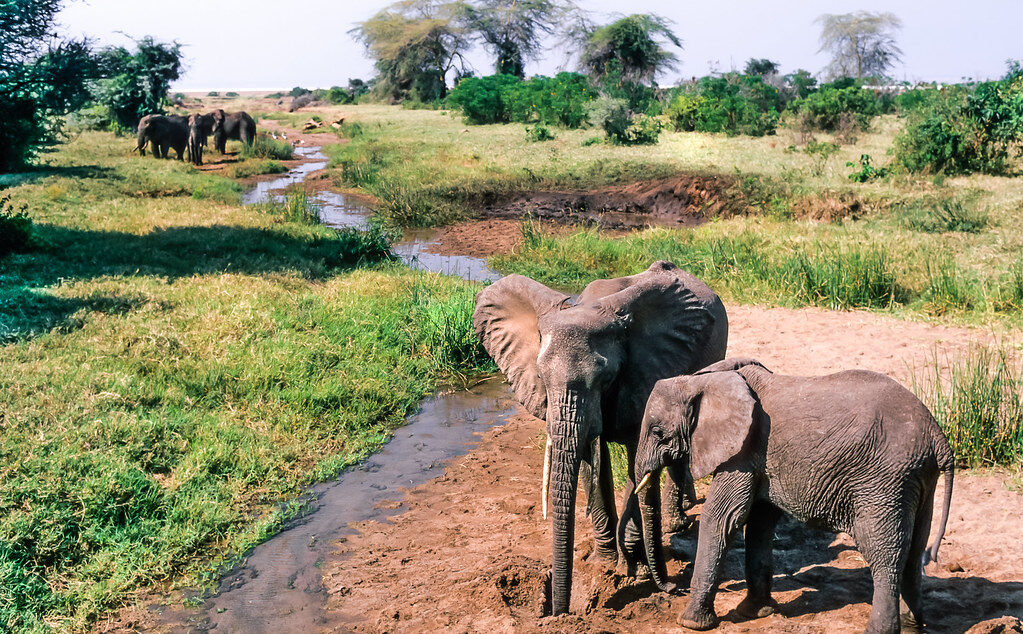
Tarangire National Park in Tanzania
Popular Destinations for Tourists: Among Tanzania’s many beautiful parks, Tarangire is home to a plethora of animals and fascinating tourist attractions, some of which are detailed below:
Animals of the wild
Regardless of the season, the northern tourist circuit of the park provides the finest game watching. Tarangire National Park is home to a wide variety of animals that can be seen on safari. These include gazelles, elephants, waterbucks, dik diks, olive baboons, leopards, lions, cheetahs, caracals, and many more species of wildlife.
Avian Life
A sanctuary for birdwatchers, Tarangire National Park has documented over 550 different species. During your birding tour in the park, you can see a variety of birds, such as the following: Yellow-collared lover bird, Vulturine guineafowl, Von der Decken’s hornbills, slate-colored boubou, Rufous-tailed weaver, pink-breasted lark, Northern white-crowned shrike, mouse-colored penduline tit, Great white pelican, Common Ostrich, Bare-faced ho away bird, Ashy starling, and African grey flycatcher, to name a few.
Regional Group
Meet the locals and learn about their culture; they are the Maasai, and they are well-known for their nomadic lifestyle.
A river in Tarangire
An integral part of Tarangire National Park’s ecosystem, this feature is a great spot to stop for a safari and see animals in their natural habitat, particularly during the dry season when they congregate along the river’s edge to quench their thirst.
The Tarangire River is a haven for many species, including a large herd of elephants that seek out the water and shade it provides. It was an exciting journey for the elephants as they dug into the sand along the Tarangire River to find underground water. You may spot many different kinds of animals, including gazelles, leopards, lions, wildebeests, zebras, and buffaloes, as they drink from the Tarangire River.
The forest of Matete
Matete is an excellent place to see leopards and the rare oryx antelope. The name of this area comes from the tall elephant grass and thorny reeds that line the riverbanks in the western part of the region. As a regular spot to see leopard, it stands as a rewarding spot. The acacia tortilla tree is a common spot to spot these shy felines.
Mount Kitibong
No safari vacation to Tarangire National Park would be complete without a stop at the exciting Kitibong Hill. Wild dogs and massive herds of cape buffalo call this park home. Cape buffaloes can be seen charging across the acacia plains, their massive bossed horns flailing in the wind.
The Marsh
The Silale wetland is a characteristic of the Tarangire environment. Various park animals and water bird species are drawn to this marsh. Animals such as elephants, leopards, cape buffalo, African wild dogs, and Silale swamp lions come to mind.
The Massive Baobab Elm
The Tree of Life is a well-known name for this. Tarangire National Park is also home to the unique boa bob. It has changed through time to fit it with its environment.
A “gigantic” vehicle with a capacity of 300 gallons of water stuns it. Its maximum lifespan is 600 years, which is quite long. Many different kinds of animals rely on the tree’s edible seeds for sustenance. Conversely, elephants train their enormous tusks on the tree bark.
Attractions for Tourists in Tanzania’s Tarangire National Park The park’s giant baobab trees
The Tarangire Wildlife Migration
Located 120 kilometers northeast of Arusha, close to the southeastern corner of Manyara National Park, Tarangire National Park is in the northern Tanzania area.
If you want to witness a lot of animals congregating near the park’s water source, you should go during the dry season. Due to the water of the Tarangire River luring large herds of animals into the park, we witness their migration. An enormous migratory process occurs every year.
Herds of gazelles, zebras, hartebeests, wildebeests, and elephants, as well as predators like lions and leopards, swarm into the Serengeti National Park during the annual wildebeest migration. As a result, a safari in northern Tanzania is a great way to see animals.
Elephant Population in Tanzania
The park is home to a large number of elephants, and the best time to see them is during the dry season, which begins in June and continues through October as the landscape gets progressively drier. In order to quench their parched bodies of water, a large herd of elephants is seen digging into the parched riverbed of the Tarangire River.
The animals scatter over the park when the rain arrives, bringing with it an abundance of pastures and water.
The Hunting Ground
Poachers used to hide out in this ancient baobab tree, which is famous for its somewhat concealed entrance and interior chamber.
When Is Tarangire National Park Most Popular?
While visitors can enjoy Tarangire National Park at any time of year, those hoping to see wildlife should go between June and October. The region’s dry season begins around this time, making it the perfect time to watch the games.
Approaching Tarangire National Park
Several modes of transportation, including roads and planes, allow visitors to Tarangire National Park easy access.
If you prefer to go by car, you may begin your journey from Arusha and reach the park in no time.
Traveling by Air: Flying is the most convenient way to reach Tarangire National Park. Both Tarangire and Kuro airstrips provide access to the park. You can reach Tarangire National Park by either charter or scheduled flight.

